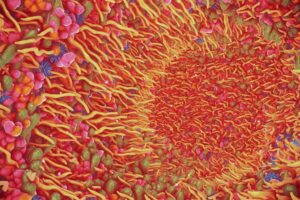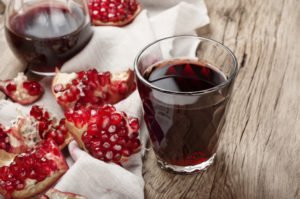What's On This Page?
ToggleMeet Akkermansia muciniphila. If your gut were a castle, this microbe would be the loyal gatekeeper, maintaining the moat, fortifying the walls, and keeping unwanted intruders at bay.

Discovered in 2004 by Dutch microbiologist Dr. Willem de Vos, Akkermansia is not your run-of-the-mill probiotic. In fact, you won’t find it in probiotic capsules because it’s oxygen-shy, hard to grow, and prefers a very specific neighborhood – the mucus lining of your gut wall.
Unlike the more famous Lactobacillus or Bifidobacterium, which live in the gut lumen (the “inner tube”), Akkermansia sets up shop right at the border (your intestinal lining), feeding on mucin. That’s the very substance your body produces to protect itself.
Oddly enough, this makes it both an “eater” and an “enhancer” of your gut barrier, repairing tight junctions and reducing inflammation as it works.
If you don’t care too much about this yet, let me tell you modern living is a bit of a microbial apocalypse! There’s stress, processed foods, antibiotics, and even overuse of antacids can wipe out Akkermansia.
Low levels have been linked to reflux, leaky gut, autoimmune flare-ups, insulin resistance, weight gain, and even brain fog. Think your Akkermansia is doing its job? There are some GI tests you can take to see what your levels look like.
🧠 Brain–Gut Connection
Akkermansia doesn’t just hang out in your belly—it whispers to your brain too. Research shows low levels are tied to mood issues and brain fog, while healthier levels may support clearer thinking and emotional balance. Simply put, a thriving gut gatekeeper means fewer mental cobwebs and a brighter outlook. For a deep dive into this topic, read my other article, 5 Tips to Boost Serotonin: How the Gut-Brain Axis Works.
Scroll below to see a 3D render of inside your gut lining. There are finger-like villi (orange) absorb nutrients, while a layer of mucus and microbes (blue specks) keep the barrier strong. This is home sweet home for Akkermansia, the tiny gatekeeper that helps protect your intestinal home.

Tests for Akkermansia and General Gut Health
There’s actually a simple stool test (offered by several labs) that can tell you if your Akkermansia is thriving, struggling, or MIA. It’s like running a gut census to see if your gatekeeper’s still on duty.
The test is usually a stool-based microbiome analysis that measures Akkermansia muciniphila levels along with other gut microbes.You can get it through companies like:
-
GI-MAP (Diagnostic Solutions Laboratory) – ordered through a practitioner
-
Genova GI Effects – ordered through a practitioner
-
Thryve / Ombre Gut Health Test – direct-to-consumer
-
Viome – direct-to-consumer
They use DNA sequencing (qPCR or metagenomics) to detect how much Akkermansia is present and compare your results to healthy reference ranges.
Is It a New Probiotic?
Akkermansia muciniphila isn’t a typical probiotic, at least not in the way we think of Lactobacillus or Bifidobacterium found in other probiotics. 🦠 What makes probiotics “probiotics” then?
Most probiotics you see in supplements (like Lactobacillus or Bifidobacterium and others) are friendly bacteria that survive the trip through your gut and deliver a health benefit when taken in adequate amounts. They usually live in the lumen (the inner tube of your intestines) and feed on fibers, carbs, or lactose.
🔍 How Akkermansia is different
-
Habitat: Instead of the lumen, Akkermansia colonizes the mucus layer of the gut lining, right at the border of your intestinal wall.
-
Fuel: It “eats” mucin (the mucus your body produces), not the same fibers most probiotics thrive on.
-
Function: It strengthens your gut barrier, repairs tight junctions, and reduces inflammation – kind of like patching up the castle walls while also standing guard.
-
Availability: Because it’s oxygen-sensitive and very hard to culture, it’s not included in most probiotic supplements. Only a few specialized products now carry pasteurized Akkermansia (like Pendulum).
✅ So is it a probiotic?
You could call Akkermansia a “next-generation probiotic” or a keystone species, but it’s not something you’ll find in your average probiotic capsule. Instead, the best way to “boost” it is by feeding it with polyphenols (pomegranate, cranberries, green tea, dark chocolate) and prebiotic fibers (acacia, resistant starch, green banana flour, etc.).
Simply put: Akkermansia is probiotic-like in its benefits, but it doesn’t behave like your typical probiotic. It’s more of a gut bodyguard that thrives when you give it the right food.
🚦 When Too Much of a Good Thing?
Like many things in medicine, balance is key. In certain animal models of inflammatory bowel disease or Salmonella infections, an overgrowth of Akkermansia wasn’t helpful, it actually damaged the mucus barrier. And while higher levels have been spotted in people with Parkinson’s or multiple sclerosis, we don’t know yet whether that’s harmful or if its just coincidence.
Simply put: Akkermansia is usually a superhero, but under the wrong circumstances, it can play the villain.
As It Pertains to Insulin Sensitivity and Diabetes
A landmark paper published in Nature Medicine found that people with higher Akkermansia levels had better metabolic health and insulin sensitivity. This bacteria keeps the whole kingdom running smoothly.
From my perspective as a pharmacist, it’s best to think of Akkermansia like a maintenance medication for your gut. Except you don’t need a prescription! Instead of a pill, it needs a steady supply of the “active ingredient” it craves: Plant-based fibers and colorful polyphenols—like acacia fiber or pomegranate—are the daily nourishment your Akkermansia depends on. Think of it like a maintenance medication—miss enough doses, and the benefits fade. Just as skipping a prescription can trigger a flare of symptoms, neglecting this microbe can weaken the gut barrier, paving the way for leaky gut, inflammation, and a cascade of health issues.

No probiotic you grab at the drugstore will magically restore your levels.
But you can create the right conditions for it to repopulate, much like preparing fertile garden soil before planting seeds. Certain spore-based probiotics can help by crowding out the bad guys and lowering inflammation so Akkermansia feels welcome again.
Feed your gatekeeper well – here’s what you should put on the menu:
4 Polyphenol-Rich Foods
Pomegranate seeds or juice
Unsweetened cranberries
Matcha green tea
Red/purple grapes (skin on!)
4 Prebiotic Fibers
Acacia fiber
Cooked-and-cooled potatoes (resistant starch bonus)
Green banana flour
Inulin (if your tummy tolerates it)
🍫 Fun Food Swaps
Supporting Akkermansia doesn’t have to feel like a chore. Here are some pharmacist-approved swaps:
-
Swap milk chocolate for a square of 85% dark chocolate.
-
Trade soda for a sparkling water with a splash of pomegranate juice.
-
Instead of chips, try apple slices with a sprinkle of cinnamon (another polyphenol!).
Each swap gives your gatekeeper something to feast on, while you still enjoy the flavor.
💊 Medications and Your Microbiome
Here’s where my pharmacist brain lights up: common meds can make or break your gut bugs. Frequent antibiotic use is like napalm for Akkermansia. Overuse of antacids and PPIs (proton pump inhibitors) can also create a terrain where this microbe struggles. If you’re taking these meds long-term, talk with your prescriber about whether they’re still necessary—or whether diet and lifestyle tweaks could reduce your dependence.
A good idea is to reduce unnecessary antibiotics and antacids because they smash this bacteria. Tame your stress with mindfulness and exercise, and eat a clean diet to keep this gut “bug” thriving. Akkermansia provides 5 important benefits – stronger immunity, smoother digestion, sharper mental clarity, better metabolic health, and improved weight balance.
🌿 Daily Rituals to Grow Your Gatekeeper
-
Start your morning with green tea instead of coffee (bonus: antioxidants without the jitters).
-
Take a 10-minute walk after meals—movement stimulates mucus production, which Akkermansia feeds on.
-
Add one extra veggie or berry to your plate each day; small steps make a big difference.
-
Prioritize sleep—yes, even gut bugs keep a circadian rhythm.

Suzy Cohen, has been a licensed pharmacist for over 30 years and believes the best approach to chronic illness is a combination of natural medicine and conventional. She founded her own dietary supplement company specializing in custom-formulas, some of which have patents. With a special focus on functional medicine, thyroid health and drug nutrient depletion, Suzy is the author of several related books including Thyroid Healthy, Drug Muggers, Diabetes Without Drugs, and a nationally syndicated column.



